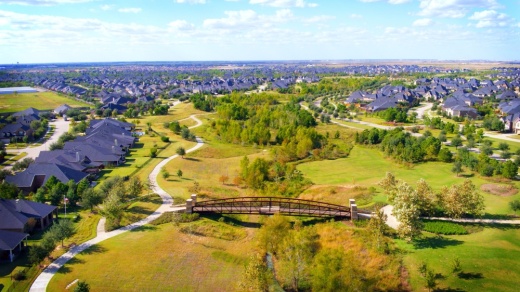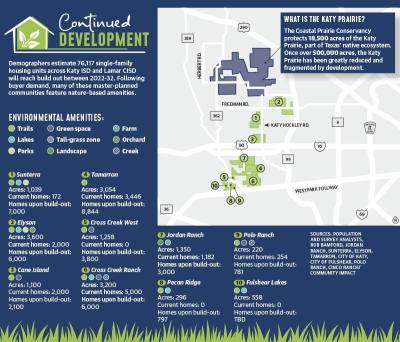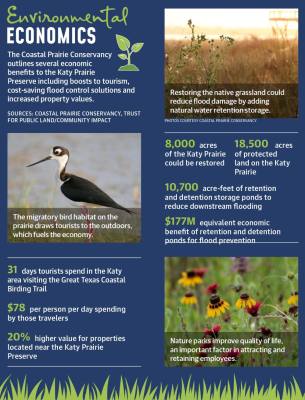The combined population of the six ZIP codes making up Community Impact’s Katy market—77493, 77494, 77441, 77449, 77094 and 77450—rose 25.19% from 2015-20, reaching 388,036 residents in 2020, per U.S. Census Bureau data.
Moreover, data from demographic firm Population and Survey Analysts estimates 104,595 new housing units will be built in Katy ISD and Lamar CISD between 2021-31.
Coastal Prairie Conservancy President Mary Anne Piacentini said she believes many developers know preserving the environment is essential, but she urges them to also consider flood mitigation.
“By law, [developments] have to have [flood] detention,” she said. “Our question is, is it enough detention?”
The nonprofit, which aims to protect and restore the native coastal prairie, is working with local governments and regional entities such as the Houston-Galveston Area Council to align conservation efforts, Piacentini said.
The cities of Katy and Fulshear have also both passed parks plans to promote nature-focused spaces for recreation and flood relief.
Mindful amenities
Communities in Katy and Fulshear are more often utilizing natural features and systems as cost-effective alternatives to traditional infrastructure, said Rob Bamford, general manager for master-planned communities Cross Creek Ranch and Cross Creek West by Johnson Development Corp.
“At a minimum, 20% of our land ends up with open space, parks, trails and detention lakes,” Bamford said.
An article from the National Recreation and Parks Association’s January 2021 publication, Parks and Recreation, said Houston began to dedicate more resources to preserving natural spaces after multiple flooding events and with the increased use of parks amid COVID-19.
For example, Cross Creek Ranch’s Flewellen Creek restoration project was completed in November 2020. Designed by ecological conservation company BioHabitats, it reconnected the 15,000-linear-foot stream to its flood plain after it had seen severe erosion from years of agricultural use and development.
It is now the centerpiece of the 3,200-acre community, Bamford said. A nature system is planned for Cross Creek West, which will add 3,110 homes between 2021-31, per PASA data.
“Water conservation is a real goal of ours, given that this commodity has become very expensive,” Bamford said.
Curt Beasley, field operations manager for the southwest division of homebuilder D.R. Horton, said the National Oceanic and Atmospheric Administration’s September 2018 Atlas 14 study of rainfall data has also influenced changes in detention requirements for these communities.
The study was conducted after Hurricane Harvey hit in August 2017, and rainfall values from the report are used to determine future flood risks and manage development in flood plains for the national flood insurance program.
“Developments that are happening now versus eight years ago have a greater chance of withstanding hurricane flooding,” Beasley said, referring to increased detention standards.
City plans
Coupled with nature-based amenities by residential developments are the cities’ efforts to restore and preserve the native ecosystem as their populations increase.
Fulshear Mayor Aaron Groff said stormwater conveyance and preserving the native trees and vegetation are pivotal environmental concerns while the city continues to grow.
“The challenge is how quickly can we get the [storm]water to the creeks that surround the city,” Groff said.
The city of Fulshear, where census data predicts the population will rise by nearly 81% between October 2022 and October 2027, has changed its zoning and density regulations to encourage preservation.
Groff said developers must dedicate 1 acre of green space for every 60 dwelling units. If 300 apartment units were built on 15 acres, it would require 5 acres of open space.
“We encourage communities to preserve ... those natural resources and even as far as taking it into our city development ordinances,” he said.
To this end, the city of Fulshear’s 2019 Parks and Pathways master plan suggested the city integrate more pedestrian trails throughout the city.
The city will complete its 11.5-acre Bessie’s Creek project in 2024, where 50% of the natural habitat will be preserved. The area is within the 100-year flood plain along Bessie’s Creek—south of Rogers Road and between the Pecan Ridge and Del Webb communities—and will feature detention and native vegetation, per plan documents.
Meanwhile, Katy finalized its parks master plan in October. One objective in the plan is installing a multipurpose facility at Leyendecker Landing, Kendig Keast Collaborative President Gary Mitchell said at an Oct. 13 meeting.
The site for Leyendecker Landing is located along the east side of Pitts Road and already serves as a stormwater detention area. Katy plans to build upon that to create a recreation space.
The city will use its 2021 parks bond to fund the project, though exact costs have not yet been determined.
Aligning goals
Native lands of the Texas Coastal Prairie spanned across the state 200 years ago; those lands have been reduced to less than 1% of its original size with most nestled within the Katy Prairie Preserve, Piacentini said.
“The Katy Prairie itself went all the way from Loop 610 to the Brazos River, up above [Hwy.] 290 and below up to about [FM] 1093,” she said. “It was a vast ecosystem with wetlands and grasslands and trees along the stream corridors basically as far as the eye could see on the horizon.”
The Coastal Prairie Conservancy land trust protects 30,000 acres of coastal lands through conservation agreements with private landowners in Harris, Waller, Fort Bend, Brazoria, Matagorda, Galveston and Jackson counties. The Katy Prairie Preserve, located in Harris and Waller counties, makes up 18,000 of those acres.
“We are still trying to buy land and protect land on the Katy Prairie, but it’s getting more expensive to do so, and Houston is spreading all over,” Piacentini said. “It is going out to places we once thought would not get developed for decades—now they are beginning to surround us.”
In 2020, the H-GAC worked with the conservancy and local officials to develop a regional framework and strategy to support conservation efforts, Piacentini said. Through the initiative, the H-GAC will assist local partners in pursuing funding, per framework documents.
The H-GAC lists several Katy and Fulshear projects as priorities in the initiative, including the 1093 Rails to Trails project, which will extend Fulshear’s Heritage Rail Trails to create a shared-use trail for cyclists along the historic San Antonio and Aransas Railway from Fulshear to Eagle Lake.
The H-GAC is also connecting the conservancy with funders to acquire conservation easements within a 9-square-mile area of the Katy Prairie Preserve, per the initiative.
Groff said he believes it is possible to parallel the area’s population growth with environmental conservation.
“If we do not continue to conserve and preserve what we do have, it’s a detriment to residential development,” he said. “We have to find that balance.”







